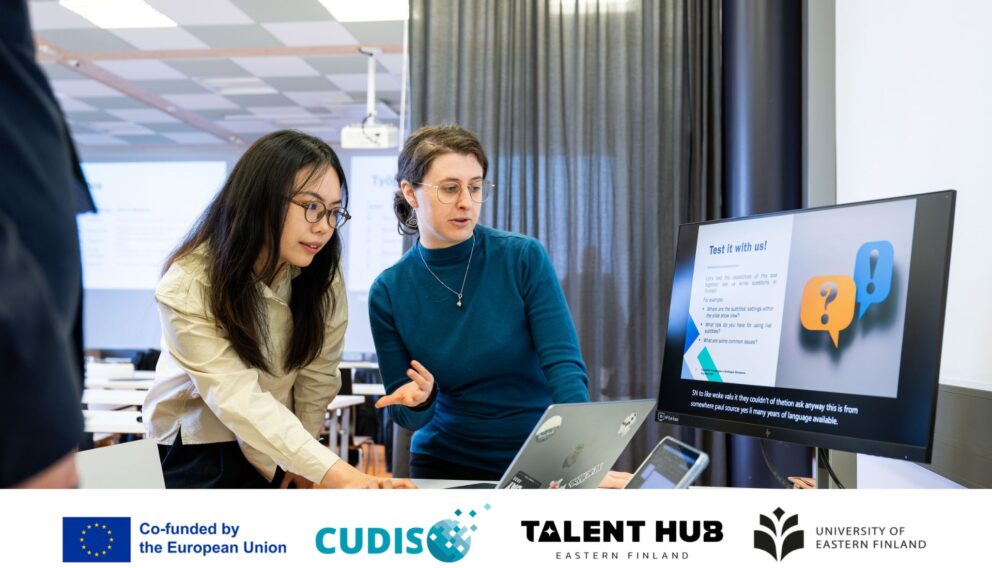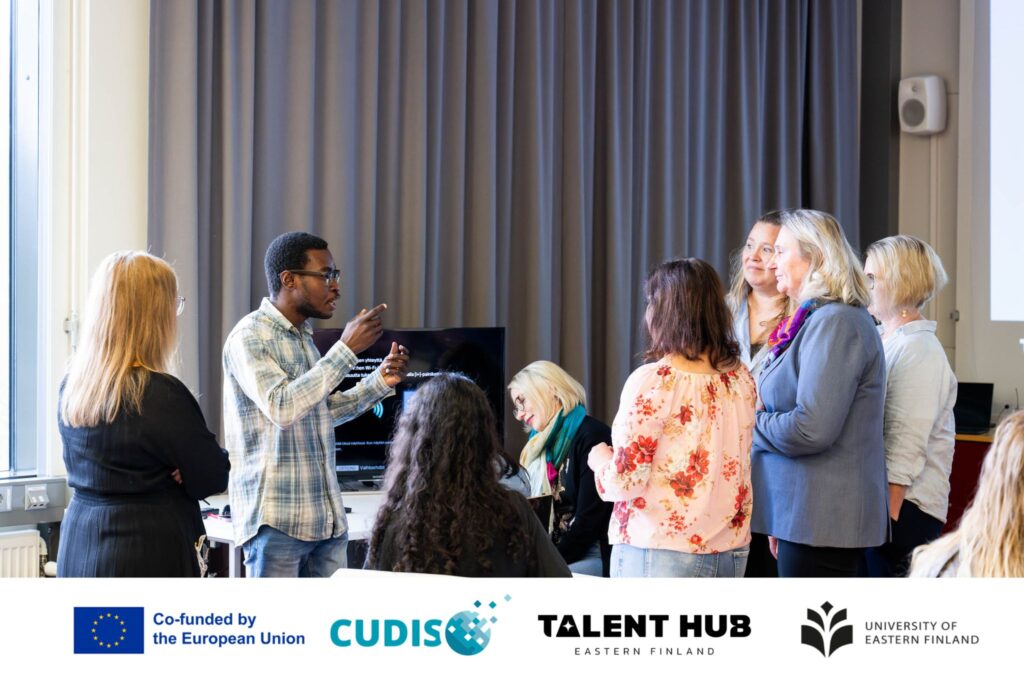Translation technologies supporting multilingual communication

How can translation technologies support multilingual communication and language learning? What should be considered when choosing applications? These questions were discussed in the Translation Technologies in Multilingual Workplaces workshop at the Joensuu Science Park on 21 May 2025. The workshop was aimed at working life representatives. The programme consisted of expert presentations and demo stations led by UEF’s international students. The workshop was organised by the Talent Hub Eastern Finland and CUDIS projects (ESF+).
Use translation technologies cautiously
Professor Maarit Koponen (UEF) gave a presentation on the potential and risks of translation technologies. Koponen introduced the theme of the day with the basics of the language models behind translation technologies. Language models process texts and language as character strings, in other words, the words are broken into “blocks” consisting of character strings. Language models are quite limited in their handling of context, as they have no knowledge of the world beyond linguistic data, Koponen reminded. For that reason, language models do not “understand” meaning, although the end product may seem convincing to the user. However, the end result may be something completely different than intended. Language is often ambiguous, hence understanding the meaning and context is very important in producing high-quality translations.
Translation technologies are a huge help for many in their daily work tasks. Their use has increased, and there are many options to choose from. For example, Google Translate and DeepL are familiar to many, and nowadays Copilot and ChatGPT are used for translation as well. Websites can be easily and automatically translated into another language by changing the language settings. There are plenty of tools and possibilities. According to Koponen, it is important to pay attention to both the intended use and the quality of machine translations. When content is translated for the purpose of disseminating information, the responsibility for the accuracy of that information lies with the author. For example, a quickly self-translated website that has not been checked can cause reputational damage to the company. On the other hand, those seeking information should be wary of the results offered by translation applications.The rarer the language pair, the greater the likelihood of fundamental errors. This also applies to the third usage of translation technologies, utilising them in face-to-face interactions. The translation may be grammatically correct but not convey the correct meaning. Fluency does not guarantee accuracy, Koponen summarised.
Translations generated by technologies may contain many inaccuracies connected to, for example, consistency, tone, reliability, or dialect, Koponen explained. A machine translation may contain many different alternatives for the same term, leading to inconsistencies in the text. The tone may also be inappropriate for the context. In fact, machine translations can contain serious errors. Koponen provided an example of such errors: Google Translator translated “bald eagle” as” karvattomapäälainen joutsen”, which roughly translates to hairless swan. Similarly, websites containing dialect words translate poorly into other languages. The result can be similar nonsense.
According to Koponen, when using translation technologies, it is important to be aware of the risks. Free applications are not secure because the data entered into them is stored on external servers and is freely available to the developer. There are also risks associated with the chosen language pair, the text type, and the context in which the translation is used. An inappropriate translation may prevent the message from being conveyed. It can lead to reputational damage or economic consequences. In the worst case, an inaccurate and poor translation can cause physical harm or even death. This could be caused by poorly translated work safety instructions or incorrect user guides. These risks are a stark reminder of the user’s responsibility when relying on translation technology.
Should we avoid using translation technologies altogether due to risks – just in case? According to Koponen, risks can be addressed from both technological and user-centered perspectives. For example, in a company, data security risks can be mitigated by implementing (for a fee) a separate tool for translations. It is also worth considering a protected translation tool tailored for the company. Additionally, it is advisable to utilise other sources of information to verify the reliability of translations.Koponen thinks that raising awareness of machine translation is a crucial part of risk management. Companies should agree on common principles in terms of choosing the right applications, checking the content, and handling data security. Offering employees training and briefings provide a good basis for the safe use of translation technologies.
Provide language learning support to employees
International employees can be supported in learning the Finnish language in the workplace in many ways, including with the help of technology. According to Continuous Learning Specialist Virpi Moilanen (UEF), learning Finnish is in the workplace is crucialnot only for workplace safety but also the involvement, wellbeing, and career development of international employees. Learning a new language at work can be quite draining due to dealing with hurries, various language backgrounds, and needs connected to work tasks. The stress is increased when the employee needs to process language in its many forms simultaneously (listening, talking, writing, and understanding). For the language learner, establishing common principles for language learning in the work community is a huge help. Moilanen provided examples of supporting language learning, for example, a language buddy or mentoring system, language-aware guidance, and clear communication. Other methods proven to work are a language lunch (for example a weekly lunch break in Finnish), phrasebanks, and a pocketbook. Moilanen also pointed out the need for language-aware leadership skills among managers. Training is needed for the management positions and operational staff.
To support language learning, there are many translation and language learning technologies and apps available. According to Moilanen, employers could support employees by offering them language learning applications, such as WordDive or Duolingo. She also mentioned Google Lens as one of the easy-to-use image apps that you can use to scan images and test and translate the information they contain. There are also (company) chatbots that can be used to explain instructions in plain Finnish or in another language. In the near future, language learners may be able to use different AR translators. For example, Google has launched eyeglasses that show the user live translations from speech projected onto the lenses. The quality of translation varies between devices and applications. Moilanen, too, reminded the participants that the user should be critical of the quality of translations.
How well do translation technologies work in practice?

The workshop provided an opportunity to explore the potential of translation technologies in working life situations in demo stations led by students from UEF’s Linguistic Data Sciences programme. The first demo showed how you can create videos in multiple languages with the HeyGen AI video generator. The user records video footage of themselves, from which the app creates a talking AI avatar. Then the user can upload text materials which are turned into realistic videos with the user’s own face. The app has several language options. In the student’s demo the language pair was Turkish-Finnish, and the result was quite fluent.
Two demo stations focused on real-time translations on PowerPoint and Google Translator. PowerPoint provided live captions in English from Italian and Mandarin Chinese as international students instructed the working life representatives in using the tools. The Google Translator demo showcased translating speech between Bengali and Finnish.In the Google Translator demo, the usershad to ask many simple and short questions from each other to get a good understanding of each other’s speech. In both demos, following the translation required concentration. In terms of interaction, the focus was fixed on the technologies instead of the other person.
Two demo stations highlighted the potential of ChatGPT. One tested the quality of translations using idioms and metaphors in Urdu/Finnish-English language pairs. The app was able to generate semantically similar phrases instead of literal translations. For example, “niin metsä vastaa kuin sinne huudetaan” (literal translation: the forest will answer you in the way you call to it”) was translated into “what goes around comes around”. Furthermore, the app could effectively provide background information on idioms and their usage contexts. The other ChatGPT demo explored how to enhance the tone of emails. With AI, users could adjust a commanding tone or replace colloquialisms to make the message more polite and appropriate for the context. However, sometimes the text generated by ChatGPT would contain expressions atypical for the context. It helps to have an ear for languages.
Final thoughts
The student-led demos showed concretely how and under what conditions translation technologies can be utilised in multilingual communication. These technologies lower the threshold for conversation and are a wonderful aid in many scenarios. However, when producing texts and content intended for publication, it is important to carefully review the final result. In summary, if you do not know the target language, have the translation done or checked by a professional translator.
Also, data protection raised some questions. Although translation technologies are a great aid in many interactions, they are not suitable for situations where personal data or other sensitive information are processed or discussed.
Another interesting observation was that we react differently to real-time translations generated by technologies than to consecutive interpreting, where a professional interpreter translates speech after a presenter. We are much more patient when it comes to humans.
The final discussion also considered the impact of technologies on interaction. In real-time translation situations, the focus is on the device and the text, or the speech produced by AI, rather than on the people present. In these situations, people pay less attention to nonverbal communication.
Based on the workshop experience, one can conclude that translation technologies help lower the language barrier. However, their use requires case-by-case assessment, caution, and training and common practices, especially in the workplace.
Original text written by Project Manager Anna Logrén
Translated by Project Secretary Oona Järvinen
Photographs by Niko Jouhkimainen (UEF)
Further reading:
Koponen, Maarit 2024. Kääntäjät ja kääntimet monikielisessä yhteiskunnassa. Professors’ inaugural lectures, University of Eastern Finland 25.9.2024. MikaEL. https://journal.fi/mikael/article/view/148322